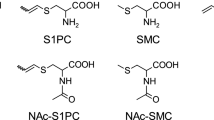Summary
S-[2-Carboxy-1-(1H-imidazol-4-yl)ethyl]-3-mercaptopyruvic acid (I) was chemically synthesized in 15% yield by incubating a reaction mixture oftrans-urocanic acid and 3-fold excess of 3-mercaptopyruvic acid at 45°C for 6 days. The synthesized compound was characterized by fast-atom-bombardment mass spectrometry and high-voltage paper electrophoresis. CompoundI was identified with a product of an enzymatic reaction ofS-[2-carboxy-1-(1H-imidazol-4-yl)ethyl]-l-cysteine (II) with rat liver homogenate in a phosphate buffer, pH 7.4. CompoundI was degraded toS-[2-carboxy-1-(1H-imidazol-4-yl)ethyl]-3-mercaptolactic acid (III), a compound previously found in human urine [Kinuta et al. (1994) Biochem J 297: 475–478], by incubation with rat liver homogenate. From these results, we suggest that compoundI is a metabolic intermediate for the formation of compoundIII from compoundII. The present pathway follows a formation of compoundII fromS-[2-carboxy-1-(1H-imidazol-4-yl)ethyl] gluthathione [Kinuta et al. (1993) Biochim Biophys Acta 1157: 192–198], a proposed metabolite ofl-histidine.
Similar content being viewed by others
References
Barden HP, Pathak MA (1967) The metabolism and function of urocanic acid in skin. J Invest Dermatol 48: 11–17
Kinuta M, Yao K, Masuoka N, Ohta J, Teraoka, T, Ubuka T (1991a) Isolation and characterization of 3-[(carboxymethyl)thio]-3-(1H-imidazol-4-yl)propanoic acid from human urine and preparation of its proposed precursor,S-[2-carboxy-1-(1H-imidazol-4-yl)ethyl]cysteine. Biochem J 275: 617–621
Kinuta M, Masuoka N, Yao K, Ohta J, Yoshida S, Futani S, Ubuka T (1991b)S-[2-Carboxy-1-(1H-imidazol-4-yl)ethyl] cysteine in normal human urine. Amino Acids 1: 259–262
Kinuta M, Ubuka T, Yao K, Futani S, Fujiwara M, Kurozumi Y (1992) Isolation ofS-[2carboxy-1-(1H-imidazol-4-yl)ethyl]cysteine from human urine. Biochem J 283: 39–40
Kinuta M, Ubuka T, Yao K, Yamada S, Yukihiro K, Tomozawa M (1993) Preparation and characterization ofS-[2-carboxy-1-(1H-imidazol-4-yl)ethyl] glutathione and its derivatives as proposed precursors ofS-[2-carboxy-1-(1H-imidazol-4-yl)ethyl]cys-teine, a compound found in human urine. Biochim Biophys Acta 1157: 192–198
Kinuta M, Ubuka T, Yao W-B, Zhao Y-O, Shimizu H (1994) Isolation ofS-[2-carboxy-1-(1H-imidazol -4-yl)ethyl]-3-thiolactic acid, a new metabolite of histidine, from normal human urine and its formation fromS-[2-carboxy-1-(1H-imidazol-4-yl)ethyl]cysteine. Biochem J 297: 475–478
Kinuta M, Sasaki K, Shimizu H, Ubuka T (1996) Isolation and characterization ofN-acetyl-S-[2-carboxy-1-(1H-imidazol-4-yl)ethyl]-l-cysteine, a new metabolite of histidine, from normal human urine and its formation fromS-[2-carboxy-1-(1H-imidazol-4-yl)ethyl]-l-cysteine. Biochim Biophys Acta 1291: 131–137
Macpherson HT (1946) The basic amino-acid content of proteins. Biochem J 40: 470–481
Pauly H (1904) Über die Konstitution des Histidins: I, Mitteilung. Hoppe-Seyler's Z Physiol Chem 42: 508–518
Scott IR (1981) Factors controling the expressed activity of histidine ammonia-lyase in the epidermis and the resulting accumulation of urocanic acid. Biochem J 194: 829–838
Toennis G, Kolb JJ (1951) Techniques and reagents for paper chromatography. Anal Chem 23: 823–826
Ubuka T (1962) Identification of isovalthine and its related compounds. J Biochem (Tokyo) 52: 440–443
Ubuka T, Ohta J, Akagi R, Hosaki Y, Ishimoto Y, Kiguchi S, Ikeda T, Ishino K (1992) Metabolism ofl-cysteine via transamination pathway (3-mercaptopyruvate pathway). Amino Acids 3:243–252
Author information
Authors and Affiliations
Rights and permissions
About this article
Cite this article
Kinuta, M., Shimizu, H., Masuoka, N. et al. Identification ofS-[2-carboxy-1-(1H-imidazol-4-yl)ethyl]-3-mercaptopyruvic acid with a metabolic intermediate betweenS-[2-carboxy-1-(1H-imidazol-4-yl)ethyl]-l-cysteine andS-[2-carboxy-1-(1H-imidazol-4-yl)ethyl]-3-mercaptolactic acid. Amino Acids 13, 163–169 (1997). https://doi.org/10.1007/BF01373214
Received:
Accepted:
Issue Date:
DOI: https://doi.org/10.1007/BF01373214




